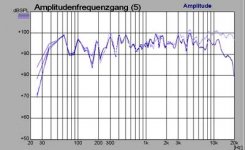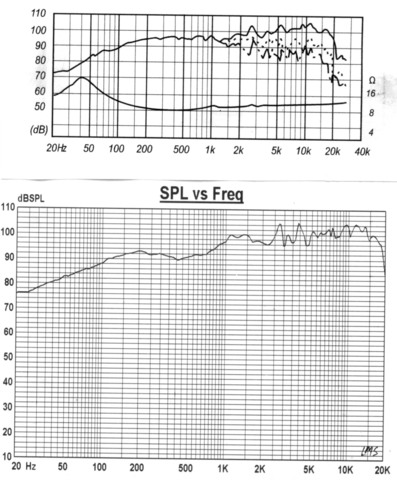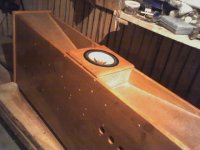scottmoose
Hello,
even a translation does not help,
B200 is no bass horn driver only for sats over 100 Hz,
see my sat horns, no filter, so this is different from the other.
to get a single driver solution with the others you need a wide enclosure, IMO more than 45 cm, to get a baffle step effect
between 400- ~800 Hz, below 400 Hz a bass horn.
because 45 cm is to much i made the SAXOPHON solution.
"Are you using 800Hz as a mean value?"
- ~ - yes + rolloff, fill correct
may be an info:
http://www.lenardaudio.com/education/07_horns.html
sax:
Hello,
even a translation does not help,
B200 is no bass horn driver only for sats over 100 Hz,
see my sat horns, no filter, so this is different from the other.
to get a single driver solution with the others you need a wide enclosure, IMO more than 45 cm, to get a baffle step effect
between 400- ~800 Hz, below 400 Hz a bass horn.
because 45 cm is to much i made the SAXOPHON solution.
"Are you using 800Hz as a mean value?"
- ~ - yes + rolloff, fill correct
may be an info:
http://www.lenardaudio.com/education/07_horns.html
sax:
Attachments
Got you Horst -we're on the same page at last; so you're using 800Hz as a convenient average to describe the point at which the rising response typical of such drivers begins, rather than stating that this exact figure applies to every driver. Fair enough. BTW -do you mean with the translation bit that you couldn't understand what I wrote above? Or that you're concerned I didn't understand what you had written?
Yes, it's not a bad page, that lenard audio one, though rather weak on detail. Good introduction for people new to horns though.
Actually, the B200 was used briefly & quite successfully by Omega in their Aperiodic 8 (defunct, as they now have propriety drivers). Couldn't do much about the rising response, which, IIRC with the B200, starts at ~600Hz, but as it beams something chronic anyway, that apparantly wasn't too much of an issue. Supposedly it sounded pretty decent down to about 45Hz or so.
FWIW, I did a BVR for the Lyeco 801 (as it was then) & B200 18 months or so back, so it is in fact possible to get some LF grunt from it, but at the price of what many would consider an over-large cabinet. I like it on OB myself.
Yes, it's not a bad page, that lenard audio one, though rather weak on detail. Good introduction for people new to horns though.
Actually, the B200 was used briefly & quite successfully by Omega in their Aperiodic 8 (defunct, as they now have propriety drivers). Couldn't do much about the rising response, which, IIRC with the B200, starts at ~600Hz, but as it beams something chronic anyway, that apparantly wasn't too much of an issue. Supposedly it sounded pretty decent down to about 45Hz or so.
FWIW, I did a BVR for the Lyeco 801 (as it was then) & B200 18 months or so back, so it is in fact possible to get some LF grunt from it, but at the price of what many would consider an over-large cabinet. I like it on OB myself.
Any low Qts driver need some help with enclousre for low and upper bass. But at my opinion powerfull magnet and very well controlled movement of the diffusor (good relation between Bl and MMS) is realy great advantage of such drivers.
Yup. More motor power the better IMO.

testimony about horst design
Horst (hm moreart),
Your enclosures seems quite interesting and among the various designs offered nowadays for fullrange drivers, they seems worth of attention .
Nonetheless, I never had an opportunity to read a testimony of people who actually hear them.
Do you have a link on other forums with testimonies of people who build your cab ?
So we can have both : the "technical" measurement and the "ears" measurement .
Have a good day !
Guillaume
Horst (hm moreart),
Your enclosures seems quite interesting and among the various designs offered nowadays for fullrange drivers, they seems worth of attention .
Nonetheless, I never had an opportunity to read a testimony of people who actually hear them.
Do you have a link on other forums with testimonies of people who build your cab ?
So we can have both : the "technical" measurement and the "ears" measurement .
Have a good day !
Guillaume
Somebody should build one of Horst's designs to hear if they're as good as claimed
I built his Schalmei Sat with B200 and it works very well. Its a bifurcated double horn and what I use now.
It is designed to be used with a sub. I have not compared it to any of the Spawn clan, don't think you can as its a different animal but I suppose that won't stop others from comparing
I am very impressed with the folding.
Andrew
hornophile
Hello,
what a name,
german test journal old but gold, look,
sorry german:
at the bottom
http://www.hm-moreart.de/71.htm
and
http://www.hm-moreart.de/74.htm
private feedback,
hello andrew, thanks for your feedback.
and measurements.
two constructions left after 36 years working,
cornet + saxophon
Hello,
what a name,
german test journal old but gold, look,
sorry german:
at the bottom
http://www.hm-moreart.de/71.htm
and
http://www.hm-moreart.de/74.htm
private feedback,
hello andrew, thanks for your feedback.
and measurements.
two constructions left after 36 years working,
cornet + saxophon
Re: soft fibre
Hi folks,
I have sheep wool in the chamber and Horst, I plan to try your trick with the soft fibre board for ceilings. AKA acoustic tiles. It's just 24 hours/day is not enough for family, job etc...
I'm probably asking too much of a compromise, as all these small horns are. I compare them with mine active studio monitors, which are extremely transparent and even in the mids, but of course have other issues.
Charcoal,
They look real fine so far!
hm said:Hello,
take soft fibre the press chamber and the first meter
of the horn, this will reduce enclosure sounds and hard
reflexions of frequencies over ~250 Hz,
you can reduce the first "Schallschnelle" over 100 Hz and
over 320 Hz the first and the second.
I optimized this old trick over the last ~28 years, look
my horns.
And most of all 8" need help below 800 Hz this does´t work with a bass horn, a horn is only good for 3 oktaven.
Don´t trust catalog measurements, compair it with real
measurements.
Hi folks,
I have sheep wool in the chamber and Horst, I plan to try your trick with the soft fibre board for ceilings. AKA acoustic tiles. It's just 24 hours/day is not enough for family, job etc...
I'm probably asking too much of a compromise, as all these small horns are. I compare them with mine active studio monitors, which are extremely transparent and even in the mids, but of course have other issues.
Charcoal,
They look real fine so far!
Don't forget that the 'ear bleeding' frequencies you refer to are well above the BW in which the cabinet is operating. It's a question of driver, not enclosure, characteristics. You might be able to do something about it with amplifier, wire or a series resistor, but short of putting them on an extremely long horn, there's little the cabinet itself will be able to do.
Scottmoose said:Don't forget that the 'ear bleeding' frequencies you refer to are well above the BW in which the cabinet is operating. It's a question of driver, not enclosure, characteristics. You might be able to do something about it with amplifier, wire or a series resistor, but short of putting them on an extremely long horn, there's little the cabinet itself will be able to do.
Hi Scott,
Could be wrong but I say nope, I had them on a simple ob and also in the bib. On ob these Sonido drivers sounded amazingly even. There were no problem with "ear bleeding" tendencies at this particular piece of music.
The only difference between bib and Sonido horn is that the resonances occur at different frequencies. However these Sonido boxes are better than the bib regarding the leakage of mids. And in both cases, problems disapear by blocking the mouth with damping material.
Peter
For sure there are issues with panel vibrations which I'm going to attend with braces.
Scottmoose said:Reflections back through the cone is a probable cause then. I can't think of any case of output at ~300Hz or lower being 'ear bleeding.' BTW -forgot to ask, were your BIBs in the room corners?
Regarding reflections, I don't think that's the cause. It's not audible when putting ear close to the cone, only when putting head down in the mouth. BTW, my wife and children thinks I'm nuts when standing with my head down in the speaker
I agree about the "ear bleeding" effect. It is higher up in the frequency as I checked with test signals. It seems like there are some high output, narrow band around 2.6-2.8 kHz from the mouth.
About bib in corners. Yes, tested in corners also.
peterbrorsson said:
It is higher up in the frequency as I checked with test signals. It seems like there are some high output, narrow band around 2.6-2.8 kHz from the mouth.
Whoa!

The damping in the throat (closed end) combined with damping through the bend should attenuate everything above a few hundred Hz at most unless it's a panel 'squeak' past the bend due to an air leak, resonant void, etc..
GM
Hi Gm,GM said:
Whoa!
The damping in the throat (closed end) combined with damping through the bend should attenuate everything above a few hundred Hz at most unless it's a panel 'squeak' past the bend due to an air leak, resonant void, etc..
GM
To be sure we're talking about the same boxes, it's the Sonido horn we're dealing with.
Haven't got time to check both of the speakers, but yes you could be right about resonance! The "ear bleeding" coincide with panel vibrations at the very end of the mouth.
Regarding leakage I have an acrylic sealer for outdoor use, in plenty amounts, at every joint. But one can never be sure...
I have no damping at the bend for now, maybe try that later.
Peter
Re: peter
Hi Horst,
I have built the middle sized Sonido horn, not the big Aion and yes, the output is quite high around 150Hz. I have concluded that already by listening and got it confirmed with an simulation of the box. No surprise there and nothing I can do with alternative damping.
You all have to have some patience with me, as it takes some time for me to evaluate sound. When having built something it's easy to fall for the novelty and being excited by a "new" sound.
Further on, my take on building loudspeakers is that it's a hobby. Life is not dependant on what is right or wrong.
Best regards,
Peter
hm said:Hello,
big sonido horn,
ask if the steps below und under the driver is mesaured,
my experience shows me close it.
------
small sonido, even with soft fibre you can´t get away the huge 150 Hz sound, this depends on length, flare rate and size.
Hi Horst,
I have built the middle sized Sonido horn, not the big Aion and yes, the output is quite high around 150Hz. I have concluded that already by listening and got it confirmed with an simulation of the box. No surprise there and nothing I can do with alternative damping.
You all have to have some patience with me, as it takes some time for me to evaluate sound. When having built something it's easy to fall for the novelty and being excited by a "new" sound.
Further on, my take on building loudspeakers is that it's a hobby. Life is not dependant on what is right or wrong.
Best regards,
Peter
- Status
- This old topic is closed. If you want to reopen this topic, contact a moderator using the "Report Post" button.
- Home
- Loudspeakers
- Full Range
- Sonido BIB



